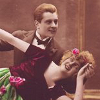Yesterday I came home from Paris thrilled with impressions. Makes it hard to choose. Where to start? With the work in the archives proving a most kafkanian experience ? Or with the great exhibitions we stumbled upon in our free moments? Let’s try to begin with some good news. ‘L’impressionisme et la Mode’ running in Quai d’Orsay for the time being (until the 20th of January 2013) is a masterpiece of an exhibition. More than worthwhile a trip to Paris. The mis-en-scène of Robert Carsen is fantastic, not to mention the rather impressive amount of masterpieces presented. One can dream away quite a few moments strolling along the crème-de-la-crème of the impressionist movement.
Where to start? First you enter a room draped with about a dozen of original dresses from between 1860 and 1870. The hayday of the second empire style in Paris. These originals are confronted with fashion revues on the one hand and on the other with contemporary photography. Even without any knowledge or experience, the comparison makes sense, running from design (sketches by fashion designers), over marketing (fashion revues) to the result in real life. But the best is yet to come. At the far end of the first exhibition room the influence fashion exerted on the impressionist painters becomes tangible. Albert Bartholomé’s painting ‘La Serre’ (The Greenhouse) – photography above – shows his wife wearing a splendid dress, which actually is presented side by side with the painting. It is completely unthinkable of course to show a painting and the original dress worn by the model at a distance of a mere 130 years. Hence the choice of thy exhibition makers not to try to repeat this trick another time. By the way one can very well consider both trades as independent art forms and the contrasts or the differences would do no credit to any of them. Except for this special case. Astounding!
Next one get’s lost among theater chairs and mirrors and not to forget an exuberant amount of masterpieces on show. Personally I was most impressed with Alfred Stevens. A rather lesser known painter today and, being a Belgian, perhaps not fitting entirely in the picture of what impressionism was about, created by the French. But what an amazing talent! And especially a top notch sales talent. A trait causing him to be envied by many of his artistic friends. Besides that he used to have quite some success with women, fancying none less than Sarah Bernard. And pour la petite histoire, he ended up dedicating more than one major work to her, among which a picturesque portrait of her taking a bath.
Let me not forget to mention the catalogue. France remains, of course, the nation of the written word par excellence. The well balanced discourse in combination with fabulous editing. I know. Of course it has to do with public attendance and numbers, etc. But even then. One should recognize that they realize the promise every time and time again. Who, by the way, would be so crazy as to en-lace some quire of matte paper into a volume filled with gloss only because fashion prints of the second empire could stand out a tad better? Hardly believable, isn’t it?
I didn’t read all of the articles of course, I’am even not tempted to do so. Entre autre because essay’s on aesthetics are mostly boring to me. To say the least. Besides that, the background reading has been superb so far. I was most attracted to the essay’s of Françoise Tétart-Vittu, being real eye openers to me. I seldom read such a captivating socio – cultural report on the Belle Epoque period. Most authors writing on fashion history are sporting about all kinds of details like the way a typical dress was cut or knitted together for the first time or something. Nothing of all this nonsense with M. Tétart-Vittu. Bone-dry analyses is what one gets. About the development of the French fashion industry. About how designers became more prominent over time, dislodging the fabric commerce. Or about how shop owners, fashion press and order – by – mail companies worked hand in hand. Selling millions of crinolines worldwide. Out of the box. DIY. Wasn’t the household knitting machine invented around the same time? They sent out Paris fashion to every corner of the globe. Making it available, affordable and contemporary for the masses. Here and know.
Today we more than ever complain about the world going mad. Forget about it. ‘Modern Times’ started yesterday of even the day before. From then on, nothing went slow again. Rather reassuring I think. So: no excuse, off to Paris, without delay, between a coffee and a cigarette. Hurry! Life is greedy after all.






